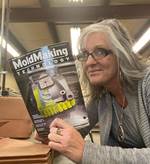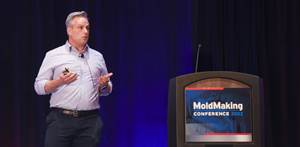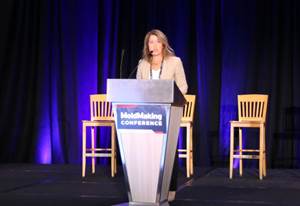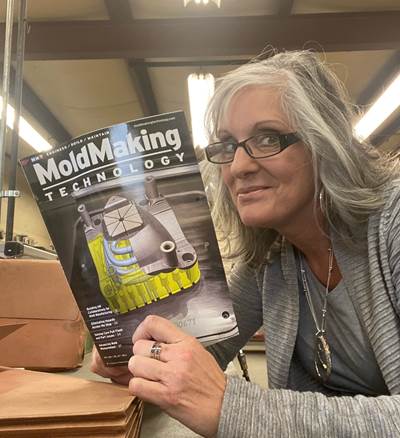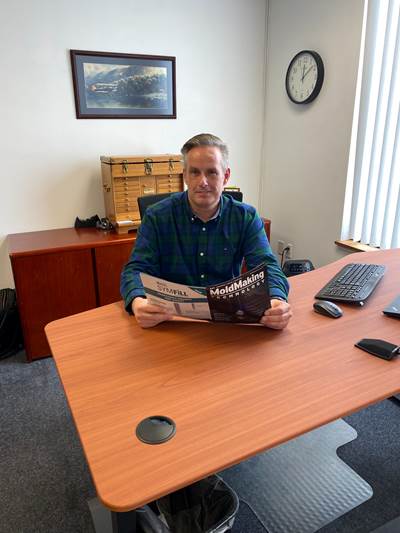Share
Read Next
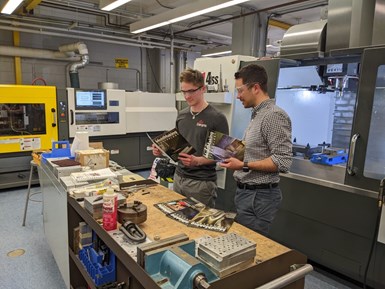
University of Massachusetts Lowell assistant professor, Davide Masato, and undergraduate plastics engineering student, Zarek Nieduzak, BS Plastics Engineering '22 reading MoldMaking Technology in the lab. Photo Credit: University of Massachusetts Lowell
Davide Masato, Ph.D., was born and educated in Italy and is now working as an assistant professor in plastics engineering at the University of Massachusetts Lowell (UMass Lowell). He has more than seven years of academic experience in plastics processing technologies, focusing on injection mold design and manufacturing. Dr. Masato strives to promote new mold design and engineering technologies and educate young plastics engineers in mold design. His assistance with changing the department's approach with their mold engineering and CAE courses once the virus hit the U.S. demonstrates his commitment to teaching.
Here, he continues this year’s EAB series by sharing his favorite three MoldMaking Technology articles and how this content has been valuable to his work.
1. August 2000 – Teach Yourself Polishing
Schools for mold polishing do not exist and most veteran polishers don’t want to teach the subject, so here are a few simple polishing guidelines.
This is an article I share with plastics engineering undergraduate students at UMass Lowell as they attend the Mold Engineering class I teach. As part of the class, students work in teams to design, analyze and injection mold a plastic part. This is the first moldmaking experience for almost all students, and they never anticipate the importance of polishing.
Reading the article ahead of time allows them to get ready for polishing their aluminum inserts and achieve good results. In addition, the article provides practical tips for polishing that inexperienced moldmakers can immediately put into practice.
For example, “Learn to use your stone to rough when you need it, how to create softer scratches and how to use the honing fluid as a last ‘polishing’ step. If you want to become a professional polisher, test every stone on a scrap piece of steel, press down as hard as you can and gradually work your way up to the finest polish you can get out of that stone. Teach yourself to know exactly what the total range is of each stone.”
2. September 2019 – Injection Molding Simulation Prediction Vs. Actual
Simulations have come a long way in the last three decades, but if we seek to prevent dimensional variation, we must understand what provides the highest level of accuracy so we can make good injection mold engineering decisions.
“A fully characterized material is one that has been tested to all the data inputs required by the software package with all the additives included. Without additives like color, slip agents, heat stabilizers, etc., the accuracy can be diminished.” This article could not express any better the importance of resin characterization for simulation accuracy.
When dealing with mold design and engineering problems, the article provides a good reminder about the importance of material properties. Another relevant aspect is the importance of meshing, which significantly contributes to the quality of the results.
When teaching simulation to undergraduate and graduate plastics engineering students, I strive to share the importance of setting up a good model and understanding the relationship between the model quality and the accuracy of the results. Finally, being able to estimate what the simulation outputs should be and comparing them to experiments is crucial.
For example, “The accuracy of the simulation is based on mesh, algorithms, material characterization, mold design, molding machine, processing and user and analysis type.”
3. November 2021 – The Ins and Outs of Hot Runner Temperature Control
A training checklist explains the why and how of proper hot runner temperature control and system management.
This article was beneficial to help my research team approach a new project focused on the hot runner molding of sustainable plastics. Installing and operating the mold, the temperature controller, the valve gates and a data acquisition unit required making sure all connections were correct and troubleshooting some errors.
The article provides an overview of a hot runner system and the workflow that should be followed for setup. For example, auxiliary I/O options. “Some controllers have three I/O connection options: contact relays, five-volt or 24-volt inputs and outputs. These are simple to set up and use to tie the hot runner controller into the injection molding cell.” Here are some examples of how to use I/O connections:
- Percentage power alarms turn off zones and the controller and serve as an output to stop the molding machine.
- Temperature alarms change conveyer direction, so parts drop in an inspection bin.
- Increased injection pressures send a signal to the controller to boost the tip temperatures.
- A signal from the molding machine automatically idles zone temperatures (e.g., if production stops, temperatures are automatically boosted to restart production).
- A soak timer from the controller to the molding machine provides the all-clear to inject.
- Preheat stations automatically boost zone temperatures before shuttling into the molding machine.”
Related Content
Navigating the Future of Mold Design and Manufacturing
What follows is a Q&A with Justin Jagels, an MMT EAB member and owner/president of J Squared Design Services LLC.
Read MoreEditorial Advisory Board 2023-2026: Meet Board Member James Jergens, Ascend Innovative Mold
The 2023-2026 version of MoldMaking Technology's EAB features a new crew of industry professionals. Meet James Jergens.
Read MoreEditorial Advisory Board 2023-2026: Camille Sackett, Vice President of Sales and Marketing for Accede Mold & Tool
The 2023-2026 version of MoldMaking Technology's EAB features a new crew of industry professionals. Meet Camille Sackett
Read MoreEditorial Advisory Board 2023-2026: Meet New Board Member Mike Close, SMC Ltd.
The 2023-2026 version of MoldMaking Technology’s EAB features a new crew of industry professionals. Here’s one of them.
Read MoreRead Next
Michiana Global Mold’s Director of Business Development Shares Three Favorite People-Focused Articles
MMT’s Editorial Advisory Board shares its top MoldMaking Technology articles of all time and how this content has been valuable to their businesses.
Read MorePenn Erie Tooling Division General Manager Shares Three Favorite Articles: People, Pins and Passing It On
MMT’s Editorial Advisory Board shares its top MoldMaking Technology articles and how this content has been valuable to their businesses.
Read MoreEAB Insight: Ideas from Our Editorial Advisory Board
In this series of articles, our Editorial Advisory Board offers their perspectives on a variety of topics that should be of interest to moldmakers.
Read More


